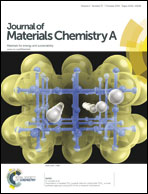A novel metal–organic gel based electrolyte for efficient quasi-solid-state dye-sensitized solar cells†
Abstract
Metal–organic skeleton based gel electrolytes are prepared for the first time for high efficiency quasi-solid-state DSSCs. The gel electrolytes feature in their sponge-like porous matrix of a metal–organic gel (MOG) assembled by coordination of Al3+ and 1,3,5-benzenetricarboxylate (H3BTC), which can provide an excellent ability to accommodate electrolyte ingredients, thus largely preserving the properties of the liquid electrolyte. Meanwhile, the MOG electrolyte can well penetrate into the photoanode film to ensure a good interfacial contact. The effects of the concentration of active species in the MOG electrolyte on the photoelectrical performances are investigated. On increasing the concentration, Jsc of gel-state cells improves gradually due to the enhanced I−/I3− redox couple content, while Voc undergoes an increase first but decreases subsequently. The synergistic function of cations (such as Al3+, Li+, etc.) and tert-butylpyridine (TBP), which can induce a conductive band (CB) shift of the TiO2 photoanode and affect the electron recombination, may contribute to the variation of Voc. By optimizing the composition of the gel electrolyte, a high conversion efficiency of over 8.60% can be obtained, which is a little lower than that of a liquid-state cell (9.13%). This research study will open up a new way to fabricate quasi-solid-state DSSCs with high efficiency.


 Please wait while we load your content...
Please wait while we load your content...